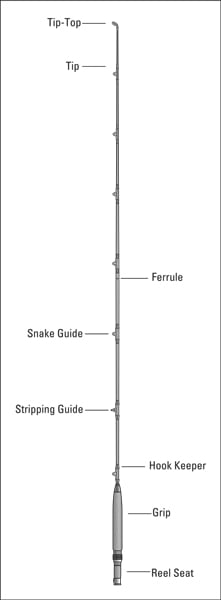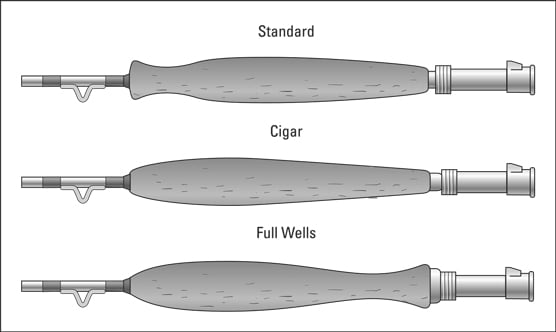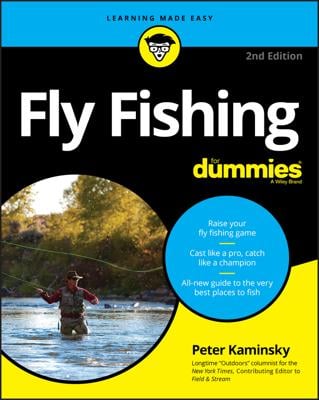 The key parts of the fly rod.
The key parts of the fly rod.The key components of a fly rod are as follows:
- The reel seat: This part holds the reel to the rod.
- The grip: Usually made of cork, it allows you to hold the rod in the proper way for the kind of casting you need to do.
- The hook keeper: A place to hook your fly when the rod is strung up and ready to fish.
- The butt: The bottom half, or third, of the shaft of the rod. As with the tip, on some rods the butt really bends, while on others it doesn’t.
- The stripping guide: This is the first guide that your line passes through as it comes off the reel. On most rods, the stripping guide is lined with ceramic to cut down on friction, which can shorten your casting distance.
- The ferrule: A male-female connection (like, for example, an electric plug) that joins one part of the rod to the other, allowing for a smooth and secure bend.
- The snake guides: Thin wire guides that help the line run straight and true without the least amount of friction. They basically form a metal squiggle, which is roughly a snake-like shape. If you have a spinning or a bait-casting rod, you will notice that these rods have circular guides the whole way up the rod, but the line that you use with conventional tackle is much thinner and not as prone to friction as the wider fly line is.
- The tip: The last foot or so of the rod. It can bend a little or a great deal and is critical in determining the action and sensitivity of the rod.
- The tip top: A round guide that directs the line out into the world and hopefully toward the fish.
You can see some of the standard grips in the following figure. Other grips are available, but they are just variations on these themes.
- The standard: A nice contoured feel that gives you gripping surface where you need it and curved spaces where your hand fits snugly.
- The cigar: The cigar grip is a pleasant, hand-filling shape (just like a real cigar), which allows you to raise your forefinger for a tighter loop in short, delicate casting situations.
- The full wells: The tapered front will allow you to raise your thumb comfortably, making for a more powerful cast with extra punch. This grip also allows for greater force in fighting the fish.
 The most popular fly rod grips.
The most popular fly rod grips.No, Butt Seriously . . .
Many fly-rod makers now offer what is called a fighting butt for rods 6 weight and up. Basically, it is an extension of the part of the rod below the reel. It allows you to jam the rod against your torso or along your forearm when you are fighting a strong fish. It gives you more leverage. So, yes, you can subdue a salmon with a light rod, but you are going to be a whole lot less tired if that rod has a fighting butt.Spey rods have been around for hundreds of years. First invented for the salmon rivers of Scotland, they have become more and more popular in recent years. There is no question that when fishing huge rivers, lakes, or surf casting, they can help you beat the wind and get off impressively long casts. They also are a godsend when there is a high bank or trees near and in back of you.
The rods are longer, and the line is heavier. They all have a distinctive long lower grip that doubles as a fighting butt and lets you get a second hand involved in casting the rod. Although they cast further, no matter how far you cast, you may rely on the law of nature that states, “The fish are always ten feet out of range!”
You Have to Cast Your Way
When it comes to casting, everyone has a different style. I have a kind of three-quarter, sidearm cast that is miles away from the classic English style of straight up-and-down arm motion where you are taught to keep your elbow snug to the ribs. It’s all a matter of finding a casting style and a rod that works for you. Some rods that more traditional casters love give me a problem. Some rods work for me at short distances, but when I really want to lay some line out there, I feel an unresponsiveness or “dead spot” (just like you’ll find in a golf club or tennis racquet). This has more to do with how I cast than the rod I’m using. So, when someone asks, “What rod is right for me?” I can give a recommendation, but in the end, you are going to have to feel your way into this and get the rod that feels best for you.If no one had said it before in other circumstances, then I am sure that some fly rodder, somewhere, would have come up with the saying, “Different strokes for different folks.” It’s worth pointing out that being big and strong is not that important for good casting. In fact, the two greatest casters—for distance and accuracy—are women: one in her 90s (Joan Wulff) and one in her teens (Maxine McCormick). Touch, feel, and finesse—not brute force—are the name of the game.

